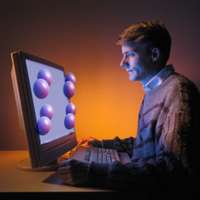Philips showcases multi-view 3-D display technology at SID 2004

At this year's Society for Information Displays (SID) conference Royal Philips Electronics is showcasing multi-view 3-D display technology for video entertainment - including gaming, automotive display and mobile applications - that allows consumers to enjoy highly-realistic visual images. The new 3-D display offerings combine Philips' unique patented slanted lenticular lens technology with real time 2-D to 3-D conversion software that can toggle between 2-D and 3-D on any type of flat display module (transmissive LCD, reflective LCD or emissive display). Philips' 3-D autostereoscopic display technology can be enjoyed by multiple viewers without the need for glasses with special lenses to experience the natural 3-D effect and also provides a wide viewing angle that can be enjoyed by multiple viewers.
With Philips' new technology, viewers have the advantage to "look around" objects without losing the stereoscopic effect or brightness of the display even during movement. Using Philips' advanced technology, a viewer is not required to hold his head in a certain position in order to examine the image, viewing it in 3-D. Multiple viewers can enjoy the 3-D image at the same time from different vantage points because of the nine separate stereoscopic views - each taken from a slightly different angle - that create a lifelike 3-D image over a broad range of viewing angles. The slanted lenticular lens focuses the light from different pixels in well-defined directions, bringing to life different sides of a picture. The lenticular lens technology also resolves the issue of moire-like black bands by slanting the lenses at an angle. In addition, the lenticular lens approach makes optimum use of the available backlight power, unlike competitive parallax barrier approaches which work by cutting out a significant fraction of the light generated by the backlight.
"Our extensive knowledge of 3-D display technology provides consumers with a very natural 3-D image that they can almost touch and feel - whether it be a photo, video or game - without compromising on brightness" said Johan van de Ven, chief technology officer, Communications Businesses, Mobile Display Systems and senior vice president, Philips Semiconductors. "We believe that this technology unlocks numerous opportunities in this growing consumer market and also in professional applications, such as medical imaging and computer graphics."
The 3-D technology is suitable for any size display in either video entertainment, automotive or mobile telecommunications applications. Philips' new 2-D to 3-D conversion technology significantly enhances graphics, video and gaming experiences. Gamers can switch between 2-D and "virtual reality" 3-D views because the display technologies contain a powerful, highly efficient conversion algorithm that reprocesses the game's depth information. The conversion algorithm - applicable to dedicated hardware, software and in combination - is unique because it locates and calculates depth from any standard 2-D video to provide a 3-D video experience in real time. For example, when a user transfers a video onto a mobile device, the algorithm immediately converts the video into the 3-D format without delay or additional software. Moreover, the display itself can be switched back to full resolution for standard 2-D applications, such as reading text.
The conversion algorithm is also designed to cope with artifacts that often accompany 3-D viewing, such as discrete changes in perceived views when moving the head in front of the display in the horizontal direction. Philips continues to dedicate efforts to understanding the human perception of 3-D images in order to continually optimize algorithms.
In automotive displays, 3-D impressions are advantageous in satellite navigations systems, for example. The 3-D rendering software generates 3-D maps on the display and provides the viewers with realistic images of their driving route or destination. The driver and passengers each have an optimal view of the 3-D display, regardless of their position in the car and while the car is in motion.
As users demand more content in mobile devices, advancement to 3-D technology is an appropriate path, particularly for displays with small-sized screens. In mobile gaming devices, the 3-D display technology creates a big impact by adding an extra dimension to the gaming experience over the conventional 2-D view. As with automotive displays, Philips' solution in mobile displays offers free viewing ranges that enable users to experience the 3-D impression even during movement.
At SID 2004 Philips will be demonstrating its 3-D display technology in video entertainment applications, on a simulated 8-inch display for automotive applications, and on a sample mobile display. Editors interested in seeing this technology firsthand or learning more about the other leading-edge solutions in Philips' advanced mobile display portfolio are encouraged to drop by booth #641 during SID, or to contact Candice Kwok of The Hoffman Agency at 408-975-3081 to schedule a one-on-one briefing with key Philips executives.
The original press release can be found here: www.semiconductors.philips.com/news/
More about principle of 3D video here

















